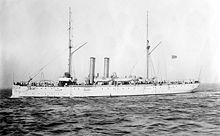USS Cleveland (C-19/PG-33/CL-21) was a United States Navy Denver-class protected cruiser.
Construction
She was launched 28 September 1901 by Bath Iron Works, Bath, Maine, sponsored by "Miss R. Hanna" (probably Ruth Hanna McCormick), and commissioned 2 November 1903, with Commander William Henry Hudson Southerland in command.[4]
Service history
The Cleveland cruised with the European Squadron, in West Indies and Cuban waters, along the east coast between Hampton Roads and Boston, and on a midshipmen training cruise until 17 May 1907. She then sailed from New York via Gibraltar, Port Said, Aden, Colombo and Singapore to Cavite, arriving 1 August 1907. After three years on the Asiatic station, the Cleveland returned to Mare Island Navy Yard 1 August 1910. Decommissioned 3 August 1910, she was placed in second reserve 8 April 1912, and returned to full commission 31 August 1912.[4]
The Cleveland alternated patrols in waters off Mexico and Central America with reserve periods at Mare Island Navy Yard between 1912 and 1917, protecting American lives and interests from the turmoil of revolution. On 31 March 1917, she arrived at Hampton Roads, and from 9 April to 22 June, patrolled from Cape Hatteras to Charleston. Assigned to escort convoys to a mid-ocean meeting point, the Cleveland made seven voyages between June 1917 and December 1918.[4] In November 1919, Cleveland returned the body of former Salvadoran president Carlos Meléndez (who had died in New York in August 1919) to La Libertad, El Salvador.[5]

Returning to patrols off Central and South America, the Cleveland was assigned to the Pacific Fleet once more from 16 February 1920, returning to Caribbean waters from time to time. She was reclassified CL-21 on 8 August 1921. During her continued service in the Caribbean and along the South American coasts, the Cleveland made courtesy calls, supported diplomatic activities, gave disaster relief, and represented American interests in troubled areas.
Cleveland was decommissioned at Boston 1 November 1929, and sold to the Union Shipbuilding Company of Baltimore, Maryland for scrapping on 7 March 1930 in accordance with the Washington Naval Treaty limiting naval armament.[4] The price for the ship was $32,000. The company's steamer Columbine took the cruiser in tow at Boston on 8 April 1930 to bring her to the ship breaking yard in Baltimore.[6]
References
- ^ "Ships' Data, U. S. Naval Vessels". US Naval Department. 1 January 1914. pp. 40–47. Retrieved 15 September 2015.
- ^ a b Toppan, Andrew (8 September 1996). "US Cruisers List: Protected Cruisers and Peace Cruisers". Hazegray.org. Retrieved 24 November 2015.
- ^ "Ships' Data, U. S. Naval Vessels". US Naval Department. 1 July 1921. pp. 60–67. Retrieved 15 September 2015.
- ^ a b c d "Cleveland I (C-19)". Dictionary of American Naval Fighting Ships. Navy Department, Naval History and Heritage Command. 30 June 2015. Retrieved 25 November 2015.
- ^ "Presidentes de El Salvador – Don Carlos Melendez" [Presidents of El Salvador – Don Carlos Melendez]. casapres.gob (in Spanish). Archived from the original on 17 March 2009. Retrieved 14 July 2021.
- ^ "Port of Boston". Boston Globe. 9 April 1930. p. 4.
Bibliography
- Sieche, Erwin F. (1990). "Austria-Hungary's Last Visit to the USA". Warship International. XXVII (2): 142–164. ISSN 0043-0374.
 This article incorporates text from the public domain Dictionary of American Naval Fighting Ships. The entry can be found here.
This article incorporates text from the public domain Dictionary of American Naval Fighting Ships. The entry can be found here.
External links
- Photo gallery of USS CLEVELAND (C 19/PG 33/CL 21) at NavSource Naval History


Recent Comments